|
|
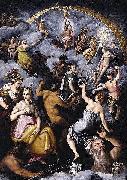 |
Jacopo Zucchi
|
|
(c. 1541- c. 1590) was a Florentine painter of the Mannerist style, active in Florence and Rome.
His training began in the studio of Giorgio Vasari, and he participated in decoration of the Studiolo and the Salone dei Cinquecento in the Palazzo Vecchio. Moving to Rome in the early 1570s, he worked for the Cardinal Ferdinando de' Medici in his Palazzo Firenze (1574). He also helped decorate, along with his brother, the apse and dome of Santo Spirito in Sassia with a fresco of the Pentecost. He painted the grand salon of the former Rucellai (now Ruspoli) palace in Rome with mythologic genealogies. Two canvases, representing the Ascension and Resurrection, are housed in the church of San Lorenzo Martire in San Lorenzo Nuovo (Italy).
|
|
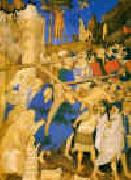 |
Jacquemart de Hesdin
|
|
French Gothic Era Miniaturist, ca.1350-1410
Jacquemart's whole career developed at Bourges (the capital of the Province of Berry) at the court of John, Duke of Berry. He was active in the Duke's service from 1384 until 1414 and made a significant contribution to the Duke's famous illuminated books, in particular the Tr??s Belles Heures du Duc de Berry, the Grandes Heures, the Petites Heures, and a Psalter, often working with the Limbourg brothers and the painter known as the Boucicaut Master.
On 28 November 1384, Jacquemart was paid for the first time by the steward of John, Duke of Berry, to cover expenses he and his wife had incurred in Bourges, and he was also paid for his clothes for the coming winter. After 1384, he was paid a regular salary.
In 1398, while Jacquemart was working for Berry in the castle at Poitiers, he was accused with his assistant Godefroy and with his brother-in-law Jean Petit of the theft of colours and patterns from Jean de Hollande, another painter who worked for Berry. Jacquemart is recorded as staying in Bourges in 1399.
The Tr??s Belles Heures du Duc de Berry (also sometimes called the Brussels Hours, from the city where it has long been kept) is chiefly the work of Jacquemart. The book is described in an inventory of Berry's library dated 1402:
?? Unes tr??s belles heures richement enlumin??es et ystori??es de la main Jacquemart de Odin. ??
The Tr??s Belles Heures disappeared for several hundred years, but the scholarly consensus is that the manuscript in the Biblioth??que Royale at Brussels is the one described in the 1402 inventory.
The Petites Heures is believed to date from before 1388, apart from a miniature of the Duke of Berry himself added later by the Limbourg brothers. Millard Meiss suggests that at least five painters worked on the book's illuminations, Jacquemart and four unidentified artists. One of these four is commonly referred to as the Pseudo-Jacquemart.
Jacquemart's small painting The Carrying of the Cross (vellum mounted on canvas, 38 cm by 28 cm, dated before 1409) is in the Mus??e du Louvre. |
|
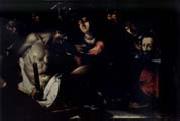 |
Jacques Bellange
|
|
French Painter, ca.1575-1616,French painter, etcher and draughtsman. His known artistic activity dates only from 1602 to 1616 and he is now familiar chiefly for his etchings and drawings, all his decorative works and most of his paintings having perished. His highly idiosyncratic style was inspired by such Italian artists as Parmigianino, by the School of Fontainebleau and by northern artists including Albrecht Derer and Bartholomeus Spranger. His work would seem to express a private and nervous religious sensibility through a style of the greatest refinement. |
|
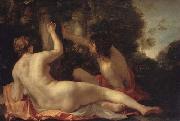 |
Jacques Blanchard
|
|
(1600 - 1638), also known as Jacques Blanchart, was a French baroque painter who was born in Paris. He was raised and taught by his uncle, the painter Nicolas Bollery (ca. 1560-1630). Jacques's brother and son, Jean-Baptiste Blanchard (after 1602-1665) and Gabriel Blanchard (1630-1704), respectively were also painters.
Jacques spent the years from 1624 to 1628 studying in Bologna and Venice. After briefly working in Turin at the court of the Charles Emmanuel I, Duke of Savoy (ca. 1628) he returned to France and set himself up in Paris in 1629. Jacques Blanchard is best known for his small religious and mythological paintings. He died in Paris in 1638. This painter should not be confused with the French sculptor of the same name who lived from 1634 to 1689.
Nothing seems to be known of his work before he left for Rome at the age of twenty-four. After two years he moved to Venice, where he remained for two more years. It was there that his style was formed. He then went to Turin, where he worked for the Dukes of Savoy, before returning to France 1628. It is from the brief but productive period after his return that all his dated works survive. They show him to stand quite apart from his contemporaries, not only in his painting style but also in his choice of sensual subject-matter, for example the Bacchanal at Nancy.
The chief influences were the sixteenth century painters, especially Titian and Tintoretto with their rich, warm colours, and Veronese, whose blond and silvery colour and limpid light he used most effectively in his small religious and mythological subjects. The several versions of Charity, depicted as a young woman with two or three children, are excellent examples of his tenderness of colour handling, and of a softness of sentiment nearer to the 18th than to the 17th century. |
|
|
|
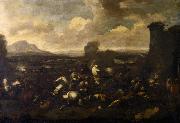 |
Jacques Courtois
|
|
(also called 'il Borgognone' or Giacomo Borgognone) (1621 - 20 May 1676?) was a French painter.
He was born at Saint-Hippolyte, near Besançon. His father was a painter, and with him Jacques remained studying up to the age of fifteen. Towards 1637 he went to Italy, was received at Milan by a Burgundian gentleman, and entered, and for three years remained in the French military service.
The sight of some battle-pictures revived his taste for fine art. He went to Bologna, and studied under the friendly tutelage of Guido Reni; thence he proceeded to Rome, where he painted, in the Cistercian monastery, the "Miracle of the Loaves." Here he took a house and after a while entered upon his own characteristic style of art, that of battle-painting, in which he has been accounted to excel all other old masters; his merits were cordially recognized by the celebrated Cerquozzi, named Michelangelo delle Battaglie.
He soon rose from penury to ease, and married a painter's daughter, Maria Vagini; she died after seven years of wedded life. Prince Matthias of Tuscany employed Courtois on some striking works in his villa, Lappeggio, representing with much historical accuracy the princes military exploits. In Venice also the artist executed for the senator Sagredo some remarkable battle-pieces. In Florence he entered the Society of Jesus, taking the habit in Rome in 1655; it was calumniously rumoured that he adopted this course in order to escape punishment for having poisoned his wife.
As a Jesuit Brother, Courtois painted many works in churches and monasteries of the society. He lived piously in Rome, and died there of apoplexy on 20 May 1676 (some accounts say 1670 or 1671).
His battle-pieces have movement and fire, warm colouring (now too often blackened), and great command of the brush, those of moderate dimensions are the more esteemed. They are slight in execution, and tell out best from a distance. Courtois etched, with skill twelve battle-subjects of his own composition. The Danzig painter called Pandolfo Reschi in Italy was his pupil.
His brother Guillaume was also a painter in Italy.
|
|
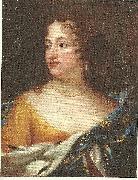 |
jacques d agar
|
|
Jacob d'Agar, född 1642 i Paris som Jacques d'Agar, död 1715 i Köpenhamn, var en fransk porträttmålare.
D'Agar var elev till Ferdinand Vouet. 1675 blev han ledamot av konstakademien i Paris; men efter det nantesiska ediktets upphävande 1685, i egenskap av reformert och därigenom utesluten och tvungen att gå i landsflykt, begav han sig över England till Köpenhamn, där han av Kristian V utnämndes till hovmålare. Mycket anlitad av hovet undanträngde han med sitt franska maner det dittills i Danmark härskande holländska porträttmåleriet. Ett av hans många porträtt av Kristian V finnes på Gripsholm. |
|
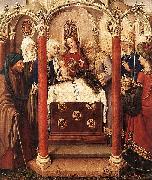 |
Jacques Daret
|
|
Jacques Daret (c. 1404 - c. 1470) was an Early Netherlandish painter born in Tournai (now in Belgium), where he would spend much of his life. Daret spent 15 years as a pupil in the studio of Robert Campin, alongside Rogier or Rogelet de le Pasture (assumed by scholars to be Rogier van der Weyden, both words meaning "field" or "meadow" in French and Dutch respectively), and afterwards became a master in his own right. He became a favorite of the Burgundian court, and his patron for 20 years was the abbot of St. Vaast in Arras, Jean de Clercq.
Though many works of Daret are mentioned in Jean de Clercq's account books, only four panels of Daret's works are known to have survived: all are from the so-called Arras Altarpiece or Saint-Vaast Altarpiece, painted for the abbot between 1433 and 1435. These paintings show a striking resemblance to the Flemish realism of the Master of Flemalle. This is argued by most scholars to be evidence that the Master of Flemalle was Daret's master, Robert Campin.
Daret features rather more in the art historical debates over his period than the merit of his work alone would justify because he is relatively well-documented, and in particular can be securely identified as the creator of the altarpiece mentioned above, as well as a pupil of Campin. The stylistic similarity between him and the Master of Flemalle is therefore crucial evidence in the identification of the latter with Campin. This then becomes an important connection in establishing a link between Robert Campin/the Master of Flemalle and his other major pupil, Rogier van der Weyden.
|
|
|
|
|
|
|
|
|
|
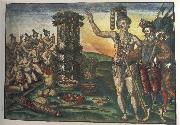 |
Jacques Le Moyne de Morgues
|
|
French painter, illustrator and explorer.
c.1533 -1588
French painter, illustrator and explorer, also active in Florida and London. In April 1564 he sailed with Ren? de Laudonni?re as artist of the Huguenot expedition to Florida. In September 1565 the Spaniards overran the colony, but he escaped and returned to France. By c. 1580 he had settled in Blackfriars, London, 'for religion' and received letters of denization on 12 May 1581. He later came into contact with Sir Walter Ralegh and his colonizing circle and with John White, the artist of the first English colony of Virginia, with whom he exchanged ideas and perhaps collaborated. Ralegh commissioned him to illustrate the Florida enterprise, and Le Moyne produced an account Brevis narratio eorum quae in Florida |
|
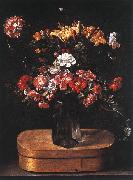 |
Jacques Linard
|
|
(1597-1645) was a French painter of the first half of the 17th century. He painted still-lives. He was baptised on the 6th of September, 1597. His first records of being of artist was in the 1620's. He was married in 1626 to the daughter of a Parisian Master Painter. In 1631 he is quoted as a painter |
|
|
|
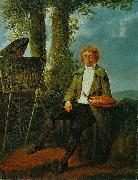 |
Jacques Sablet
|
|
Jacques Sablet (1749 - 1803) was a Swiss painter. Son of a decorator and gilder from Lausanne, he studied with his father before moving to Paris in 1772; there he worked with Joseph-Marie Vien for three years. When in 1775 Vien was named director of the French Academy in Rome, Sablet accompanied him there. His ambition was to be a history painter, but facing competition from Jacques-Louis David and Pierre Peyron, among others, and lacking solid academic training, he could win no commissions. Instead he turned to portraiture , genre painting, and landscape painting. Most of his genre scenes depicted the city's everyday life and customs of the Campagna. Sablet shared a studio with history painter Hubert Drouais and was friends with Simon Denis. He fled to Florence in 1793 with the rise of anti-French sentiment in the Papal States, but perhaps because of the competition he would face there from Louis Gauffier he soon returned to Paris. |
|
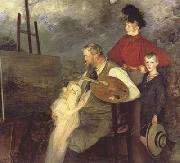 |
Jacques-Emile Blanche
|
|
(1 January 1861 - 20 September 1942) was a French painter born in Paris. His father was a successful psychiatrist who ran a fashionable clinic, and Blanche was brought up in the rich Parisian neighborhood of Passy in a house that had belonged to the Princesse de Lamballe. Although he received some instruction in painting from Henri Gervex, he may be regarded as self-taught. He became a very successful portrait painter, with a style derived from 18th-century English painters such as Thomas Gainsborough as well as Edouard Manet and John Singer Sargent. He worked in London, where he spent time from 1870 on, as well as Paris, where he exhibited at the Salon and the Sociate Nationale des Beaux-Arts. One of his closest friends was Marcel Proust, who helped edit several of Blanche's publications. He also knew Henry James and is mentioned in Gertrude Stein's The Autobiography of Alice B. Toklas. Among the painter's most famous works are portraits of his father, Marcel Proust (Private collection, Paris), the poet Pierre Louÿs, the Thaulow family (Musee d'Orsay, Paris), Aubrey Beardsley (National Portrait Gallery, London), and Yvette Guilbert.
He was the author of the unreliable Portraits of a Lifetime: the late Victorian era: the Edwardian pageant: 1870-1914 (London: J.M. Dent, 1937) and More Portraits of a Lifetime, 1918-1938 (London: J.M. Dent, 1939). |
|
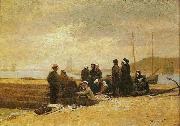 |
Jacques-Eugene Feyen
|
|
(1815, in Bey-sur-Seille, Meurthe-et-Moselle - 1908) was a French painter.
The elder brother of painter Auguste Feyen-Perrin, Jacques-Eugene enrolled at the Ecole des Beaux-Arts and studied under Paul Delaroche. He had a notable career at the Paris Salon from 1841 to 1882. Vincent Van Gogh was a fan of Feyen and describes him as, "one of the few painters who pictures intimate modern life as it really is, and does not turn it into fashion plates." He set up studio and settled in summer in the town of Cancale.He spent several months every year painting views of Cancale, the oyster-picking Cancalaises and the bay of Mont St. Michel, and his paintings still enjoy a steady fame.
|
|
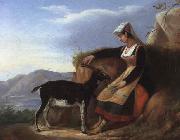 |
Jacques-Francois Ochard
|
|
was a French artist, remembered as the first art teacher of Claude Monet at his high school.
Ochard had been a student of Jacques-Louis David (1748-1825), and lived in Normandy, to where Monet's family had moved in 1845. Ochard's method of instruction was the traditional one of drawing from plaster casts of the human figure.
|
|
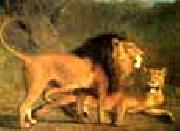 |
Jacques-Laurent Agasse
|
|
1767-1849
Swiss
Jacques-Laurent Agasse Galleries
(b Geneva, 24 March 1767; d London, 27 Dec 1849). English painter of Swiss birth. Born into a wealthy and politically influential Huguenot family, Agasse spent his early childhood at the country estate of Cravin, where he may have developed the interest in animals and natural history that was to guide his later career as an artist in England. Agasse trained first at the Ecole du Colibri in Geneva and subsequently in Paris under Jacques-Louis David (beginning in 1787) and possibly under Horace Vernet. His early artistic output consisted chiefly of unpretentious silhouette cut-outs in the style of Jean-Daniel Huber. At this time he also undertook a serious study of dissection and veterinary science. |
|
 |
Jacques-Louis David
|
|
French
b.Aug. 30, 1748, Paris
d.Dec. 29, 1825, Brussels
Jacques-Louis David is famous for his huge, dramatic canvasses of Napoleon and other historical figures, including Oath of the Horatii (1784), Death of Marat (1793) and The Sabine Women (1799). Early in his career he was a leader in the neoclassical movement; later his subjects became more modern and political. David was himself active in the French Revolution as a supporter of Robespierre and is sometimes called the chief propagandist for the Revolution; after the Reign of Terror ended he was briefly imprisoned for his actions. When Napoleon took power David became his court painter and created several grand canvasses of the Emperor, including the heroic Napoleon Bonaparte Crossing the Alps (1801) and the enormous Coronation of Napoleon and Josephine (1807). David also painted Napoleon in His Study (1812), with its famous image of Napoleon with one hand tucked inside his vest. After Napoleon ouster David went in exile to Brussels, where he remained until his 1825 death |
|
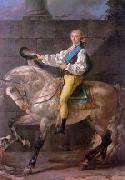 |
Jacques-Louis David
|
|
Jacques-Louis David, France Neoclassicism painter, b.1748 - d.1835. Jacques-Louis David is famous for his huge, dramatic canvasses of Napoleon and other historical figures, including Oath of the Horatii (1784), Death of Marat (1793) and The Sabine Women (1799). Early in his career he was a leader in the neoclassical movement; later his subjects became more modern and political. David was himself active in the French Revolution as a supporter of Robespierre and is sometimes called the chief propagandist for the Revolution; after the Reign of Terror ended he was briefly imprisoned for his actions. When Napoleon took power David became his court painter and created several grand canvasses of the Emperor, including the heroic Napoleon Bonaparte Crossing the Alps (1801) and the enormous Coronation of Napoleon and Josephine (1807). |
|
|
|
|
|
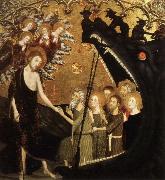 |
jaime serra
|
|
(birth unknown-died after 1405) was a Catalonian painter. Serra was influenced heavily by a Sienese style introduced by Ferrer Bassa. His altarpiece The Holy Spirit can be found in the Manresa cathedral. |
|
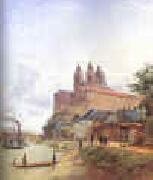 |
Jakob Alt
|
|
1789-1872
Austrian
Jakob Wassermann was born on March 10, 1873, in Furth, the son of a Jewish merchant. After a childhood with many restrictions, he began his career as an office clerk, in Munich and then in Freiburg. In 1898 he moved to Vienna and eventually established himself as a writer. Derivative and imitative, Wassermanns novels showed from the outset a strong dependence upon Fyodor Dostoevsky - particularly in his fondness for the psychological probing of criminals and social outcasts - as well as the influence of the master of the romantic horror and detective story, E. T. A. Hoffmann.
Wassermanns first significant work is Die Juden von Zirndorf (1897, The Jews of Zirndorf), in which his deep knowledge of his own community in F??rth and Nuremberg stands him in good stead. As in many of his other works, Wassermanns preoccupation with innocence and redemption is here interleaved with a somewhat crass depiction of depravity and superstition. Der Moloch (1902) pays tribute to the contemporary literary cult of the great city (here Vienna), seen as an all-devouring monster of sin and perversion. Caspar Hauser (1908) is probably the authors best novel; the book, based on fact, deals with the case of the mute youth who appeared one day in 1828 on the streets of Nuremberg. Resemblances to Dostoevskys The Idiot may also be noted in this tale of the rejection and contamination of innate purity by corrupt society.
After Caspar Hauser Wassermanns novels and short stories become increasingly preoccupied with bizarre and perverse anecdotes and intrigue, often initially drawn from biography or the newspapers. Das Gansemannchen (1915; The Goose Man) illuminates the problem involved in simultaneous cohabitation with two wives. Christian Wahnschaffe (1919) exploits the theme of the rich mans son who rejects the world to turn toward Buddhism. Der Fall Maurizius (1928, The Mauritius Case) is a type of detective novel made colorful by excursions into hypnosis but also weighed down by a tedious mass of psychological dissection. Like Honor?? de Balzac, whom he imitated, Wassermann introduces the same characters into different novels; thus Etzel Andergast (1931) is a sequel to The Mauritius Case, and its hero, Joseph Kerkhoven, reappears in Joseph Kerkhovens dritte Existenz (1934, Joseph Kerkhovens Third Existence).
Wassermann is a somewhat uneven and labored writer, and he cannot in any sense be considered a stylist. His novels are often marred by diffuseness and miasmic obscurity. At the same time his extensive output is of considerable historical interest and illuminates rather well the consequences of marriage between the new depth psychology and the popular novel of sensation and crime. He died on Jan. 1, 1934, in Alt-Aussee. |
|
 |
Jakob Bjock
|
|
Jakob Björck (1726 - 1793, Stockholm ) was a Swedish portrait painter. He was a student of the pastellist Gustaf Lundberg. |
|
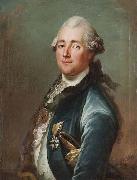 |
Jakob Bjork
|
|
painted Portrait of Jacob Johan Anckarstrom the older in 1776(1776)
|
|
|
|
|
|
|
|
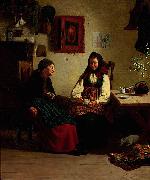 |
Jakob Kulle
|
|
painted Allmogeinterior med kaffedrickande kvinnor in 1876 |
|
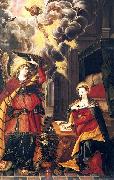 |
Jakob Mertens
|
|
Jakob Merten (August 11, 1809 - February 22, 1872) was a German Catholic theologian who was born in Wittlich.
He studied theology in Trier, where in 1833 he received his ordination. Subsequently he became a chaplain in Trier, where he worked closely with Franz Peter Knoodt (1811-1889). From 1843 to 1868 he was a professor of philosophy at the Episcopal Seminary in Trier.
Initially a prominent follower of Anton Genther's philosophy, Merten eventually abandoned Gentherianism as his career progressed. He was author of an essay on Gentherian philosophy titled Hauptfragen der Metaphysik in Verbindung mit der Speculation (Primary Questions of Metaphysics in Association with Speculation) (1840). Other noted works by Merten include:
Grundriss der Metaphysik, (Outline of Metaphysics); 1848
Der selige Frings und sein Freund als Antigentherianer; 1852
Bemerkungen zur Metaphysik von Balmes, (Remarks on the Metaphysics of Balmes); 1859
|
|
|
|
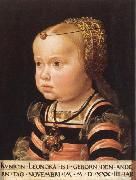 |
jakob seisenegger
|
|
Jakob Seisenegger (1505 ?C 1567) was an Austrian painter used by Charles V. He won international fame for his use of full-length poses in his portraits, creating a model used by future artists, such as François Clouet. His portrait Emperor Charles V with Hound (1532), currently resides in the Kunsthistorisches Museum Vienna. |
|
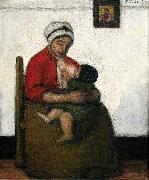 |
Jakob Smits
|
|
Jakob Smits or Jacob Smits (Rotterdam, 9 July 1855 - Achterbos (Mol), 15 February 1928) was a Dutch-Flemish painter. He was born as son of a decorator. Jakob studied in Rotterdam at the academy and helped its father in the decoration business. From 1873 up to 1876 het studied at the Academy in Brussels, and afterwards also in Munich (1878-1880), Vienna (1880) and Rome (1880). In 1882, Jakob married his cousin Antje Doetje Kramer. They settled in Amsterdam, where Smits worked as a painter. He carried out, among other things, tasks for the museum Boijmans-Van Beuningen in Rotterdam. Out of the marriage of Jakob and Antje two children, Theodora and Annie, were born. In 1884, the couple divorced.
Jakob Smits moved to Blaricum and in Haarlem becomes director of the Nijverheids- en Decoratieschool (E: Industry and Decoration school). He gets to know Albert Neuhuys, a painter of the The Hague School, and together they make excursions to Drenthe and the Campine in Belgium. Jakob Smits becomes impressed by the Campine landscape and he establishes himself in 1888, definitively in Achterbos (Mol). He pays 2,000 Belgian francs for a small farm which he develops to his Malvinahof. In the same year he marries Malvina Dedeyn, the daughter of a Brussels lawyer, who is disinherited because of this marriage. Smits lives in poverty while he works tirelessly for what he will call my simple work, symbolic, poetic and real. In 1897, he received a gold medal for his exhibitions of large water-colour paintings on a gold background in Munich and Dresden. He also paints a lot of portraits, especially of Malvina and of their children Boby, Marguerite and Kobe. In 1899 destiny strikes: in a few days time he loses his daughter Alice and his wife. In 1901, Smits marries with Josine Van Cauteren. In the same year he holds his first individual exposition in Antwerp. There he obtains much praise of colleagues and critics but finds no buyer for his work. The exhibited work De vader van de veroordeelde (E: the father of the convict) was acquired later that year by the Museum of Brussels.
Smits financial situation improved somewhat, but his family was put heavily on the test. In 1903 both his parents were ruined by a robbery and as a resulthe now had nine family members to maintain. At the request of the municipal authorities of Mol, Smits in 1907, arranged an international exhibition of artists who came to paint landscapes in Mol and its surroundings. The artist Paula Van Rompa-Zenke belonged to the arranging committee. There were no less than 68 painters participating, with Germans, Dutch, and Americans coming to Mol. The term Molse School was born. In 1910, Smits published an album with 25 engravings, which was dedicated to Queen Elisabeth. In 1912, the young Dirk Baksteen became a student of Smits.
In 1914, Smits stopped with the production of art work. He became President of the Comite voor hulpverlening en voedselvoorziening van het canton Mol (E: Committee for assistance and food supplies of the canton Mol). After World War I he continued his work with a totally new vision and style as engrave and painter. |
|
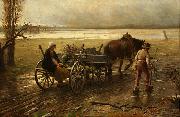 |
Jakub Schikaneder
|
|
(February 27, 1855, Prague - November 15, 1924, Prague) was a Czech painter, known for his soft paintings of the outdoors, often lonely in mood. The National Gallery in Prague held an exhibition of his paintings from May 1998 until January 1999.
He was descended from Urban Schikaneder, the elder brother of the librettist Emanuel Schikaneder.
|
|
|
|
|
|
|
|
 |
James Abbott Mcneill Whistler
|
|
American Tonalist Painter and Printmaker, 1834-1903, He was an American-born, British-based artist. Averse to sentimentality and moral allusion in painting, he was a leading proponent of the credo "art for art's sake". His famous signature for his paintings was in the shape of a stylized butterfly possessing a long stinger for a tail. |
|
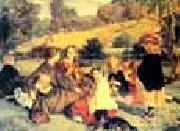 |
James Archer
|
|
1823-1904
British
James Archer (1823-1904) was a portrait-painter. He was born in Edinburgh, Scotland. His best-known work includes children and people in costume as its subjects becoming the first Victorian painter to do children's portraits in period costume. He studied at the Trustee's Academy in Edinburgh under Sir William Allan. At Archer painted chalk portraits, but in 1849 he exhibited his first historical picture 'The Last Supper' at the Royal Scottish Academy. His work after that mostly consisted of scenes taken from literature or legends that were popular at the time, such as Shakespeare and King Arthur. In about 1859 he began to paint a series of Arthurian subjects, including 'La Morte d'Arthur' and 'Sir Lancelot and Queen Guinevere'. James Archer died in 1904 in Haslemere in Surrey, England, survived by his son and three daughters from his marriage to Jane Clerk. |
|
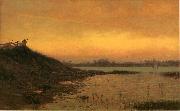 |
James Augustus Suydam
|
|
(1819-1865) architect, lawyer, and artist; as an artist was considered one of the premier Luminism painters. He is widely known as an American landscape painter and one of the leading members of the Hudson River School.
James Augustus Suydam was descended from an old New York Dutch merchant family. He graduated from New York University (then the University of the City of New York), and began his career as a businessman but turned a significant portion of his energies to painting, studying under famed artist and portrait painter Minor C. Kellogg. At the age of thirty he was elected to the Century Association.
One of the "regulars" who gathered to paint at North Conway, New Hampshire, he exhibited Conway Meadows at the New York Athenaeum and Boston Athenaeum. He opened his studio at the noted 10th Street Studio Building, New York City, in 1858. The following year he was elected an honorary professional member in the prestigious National Academy of Design, which granted him full membership in 1861. He died suddenly in North Conway at the age of 46.
James Suydam was described by his friend, the accomplished artist Sanford Robinson Gifford as a "thoroughly educated and accomplished man. " In addition to his work as an artist, which he began only after working in law and architecture, he was widely read and well-versed in history, philosophy, and the sciences. His work as a landscape painter reflects this breadth of knowledge and reveals Suydam as a deeply spiritual individual. Using his familiarity with science, Suydam reduced nature to calm, clean, planar forms, and then distorted proportional relations so that God's creations loomed superior over the work of man.
The National Academy has most of his works such as Paradise Rocks (1865), and the Taft family's Taft Museum also holds works. The Taft also has a podcast website for this artist.
A painting of Gifford's from 1859 which Suydam, according to a report, "donated to the [National] academy in 1865," became the subject of a deaccession controversy at the Academy in late 2008.
|
|
 |
James Baker Pyne
|
|
English Painter, 1800-1870
He was articled to a Bristol attorney, but around 1821 he took up painting and exhibited at the Bristol Gallery of Arts in 1824. Apparently self-taught, he worked closely with the Bristol artist Samuel Jackson (1794-1869) for a time and was influenced by the poetic landscapes of Francis Danby. In 1835 he moved to London and exhibited at the Royal Academy the following year. He showed seven pictures there altogether, but he also exhibited at the British Institution and showed 206 works at the Society of British Artists. Although technically accomplished, Pyne's work is curiously lacking in distinction. He imitated many artists but never found a style of his own. His early views of Bristol are among his best work, a good example being View of the Avon from Durdham Down (1829; Bristol, Mus. & A.G.). He also painted some lively coast scenes such as Whitby (Leicester, Mus. & A.G.). He was less successful when emulating J. M. W. Turner. |
|
|
|
|
|
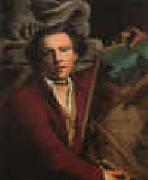 |
James Barry
|
|
b.Oct. 11, 1741, Cork, County Cork, Ire.
d.Feb. 22, 1806, London, England.
Irish James Barry Gallery
was born on 9th November at Captain Lieutenant Bouchiers quarters at the Old Train Barrack Yard in Ann Street, Belfast, Co. Antrim in the north of Ireland.
Although Barry lived his adult life as a man, his true gender is unknown. It is widely accepted that Barry was a woman who chose to live as a man so that he might be accepted as a university student and be able to pursue his chosen career as a surgeon. |
|
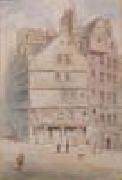 |
James Baynes
|
|
James Baynes (5 April 1766 ?C 12 May 1837) was an English watercolour painter and drawing-master.
Little is known of his family apart from the fact that he was born in Lancaster as the song of a local tradesman and was the eldest of six children, his grandfather being a Catholic priest in Kirkby Lonsdale where his father was born. As a boy he showed a love of the arts and had been employed to draw heads and work devices until Dr. Campbell, a local Physician, having seen some of these works sent some sketches to his friend George Romney. The young Baynes was then sent to London to study under Romney at the expense of Dr. Campbell.
In 1784, at the age of 18 he became a student at the Royal Academy. He wedded Mary Mann (1766-1845) in 1785 at Marylebone Church, London. Their son, Thomas Mann Baynes (1794-1854), was also became a noted watercolour artist. |
|
|
|
|
|
|

